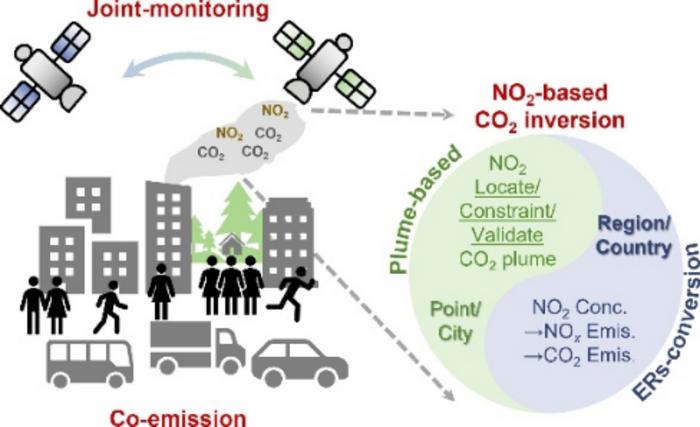Reliable monitoring of CO₂ emissions is becoming increasingly crucial as the world grapples with climate change challenges. Traditional methods, which primarily involve ground-based measurements and extensive inventories, are often marred by resource demands and inaccuracies. Such limitations have pushed scientists and researchers to explore alternative methodologies, particularly those harnessing the power of space technology. Satellite observations, specifically of nitrogen dioxide (NO₂), have emerged as a promising strategy in this quest to enhance the precision of CO₂ emissions monitoring.
The persistence of CO₂ in the atmosphere complicates efforts to pinpoint localized emissions sources. Because CO₂ has a long atmospheric lifetime, determining whether a particular spike in emissions is due to human activity or a natural process poses a significant challenge. Moreover, the presence of natural emissions and background concentrations of CO₂ can mask the signals arising from anthropogenic activities. As a result, there is an urgent need for improved and innovative monitoring techniques capable of disaggregating these overlapping signals.
Recently, a team of researchers from Tsinghua University unveiled a groundbreaking methodology that leverages satellite observations of NO₂ to monitor fossil fuel CO₂ emissions. Published in the esteemed journal “Frontiers of Environmental Science & Engineering,” the study aims to redefine how we measure emissions by introducing two key methodologies using NO₂ as a proxy for CO₂ emissions. This cutting-edge research paves the way for a more comprehensive understanding of emissions from various sources, such as power plants and transportation.
The first of these methodologies, known as the plume-based approach, focuses on utilizing NO₂ measurements to detect and substantiate CO₂ plumes. This technique enhances the ability to accurately identify emissions stemming from specific point sources. By analyzing the movement of NO₂ plumes, scientists can trace emissions back to their origins, quantifying their magnitude with unprecedented accuracy. Such precision is especially beneficial in densely populated urban areas where multiple emission sources exist, facilitating a clearer distinction between emissions generated by different facilities.
On the other hand, the emission ratio-based approach takes a broader view. It estimates emissions of nitrogen oxides (NOₓ) using NO₂ data to calculate corresponding CO₂ emissions, applying established CO₂-to-NOₓ emission ratios. This methodology proves particularly effective when assessing emissions over larger geographical scales—regional or national levels—where typical CO₂ observations may be compromised due to elevated background concentrations. By factoring in emission ratios, this innovative approach accounts for variations in fuel types and combustion processes, yielding a more accurate and reliable estimation of CO₂ emissions.
The research also delves into the uncertainties that accompany these methodologies. The relationship between NO₂ and emissions is not straightforward, introducing structural uncertainties that must be acknowledged. Furthermore, data-related challenges, such as retrieval accuracy and the trustworthiness of prior emissions inventories, complicate the landscape. To ameliorate these uncertainties, the researchers advocate for future deployment of next-generation satellites equipped with advanced capabilities alongside the creation of sophisticated inversion systems designed to enhance data processing and comprehension.
Dr. Bo Zheng, a prominent associate professor at Tsinghua University and a principal author of the study, noted that their findings signify a considerable advancement in emissions monitoring. Harnessing NO₂ as a proxy for CO₂ emissions offers a level of accuracy and reliability previously unattainable. This enhancement is crucial for formulating and executing effective climate policies aimed at mitigating the stark repercussions of climate change.
Furthermore, the implications of this groundbreaking methodology extend far beyond academia. The ability to accurately monitor emissions stands at the core of national and international efforts to achieve climate goals, particularly those outlined in the Paris Agreement. Countries must assess their progress towards these commitments, and the new methodology presented offers the potential for tailored and effective mitigation strategies essential for combating climate change. The capacity to track CO₂ emissions accurately provides an invaluable instrument for researchers and policymakers alike, allowing for a more informed understanding of emissions dynamics and their ecological impacts.
Significantly, as governments and organizations around the globe ramp up their commitments to reducing greenhouse gas emissions, the findings from this study present an avenue toward greater accountability. Policymakers can utilize accurate data to develop targeted strategies, ensuring that efforts to reduce emissions are not only efficient but also equitable. This methodology could very well become a cornerstone technology for informing climate action at both regional and national levels.
The significance of such advancements cannot be overstated. In the age of digital transformation, combining satellite technology with traditional environmental science holds immense potential for not just measuring emissions but also engaging broader stakeholders. By democratizing access to emissions data, the scientific community can engage a diverse group of stakeholders, including corporations, non-profits, and the public, culminating in collective action to protect the environment.
As researchers continue to refine and optimize these methodologies, there is excitement about the prospect of utilizing enhanced satellite technology in future studies. This research signifies the start of a new era in emissions monitoring, where sophisticated approaches offer the promise of redefining how the world gauges CO₂ emissions.
In conclusion, the advent of utilizing satellite observations of NO₂ provides a revolutionary perspective on the monitoring of CO₂ emissions. By addressing existing challenges and harnessing innovative methodologies, researchers at Tsinghua University have laid essential groundwork for advancing climate action. Their efforts stand to transform not only emissions research but the broader landscape of environmental management in the face of climate change.
Subject of Research: Monitoring fossil fuel CO₂ emissions using satellite observations of NO₂.
Article Title: Monitoring fossil fuel CO₂ emissions from co-emitted NO₂ observed from space: progress, challenges, and future perspectives.
News Publication Date: 18-Oct-2024.
Web References: https://journal.hep.com.cn/fese/EN/10.1007/s11783-025-1922-x
References:
Image Credits: Hui Li, Jiaxin Qiu, Kexin Zhang, Bo Zheng.
Keywords
Tags: advanced emission measurement techniquesanthropogenic vs natural emissionschallenges in CO2 source identificationclimate change mitigation strategiesCO2 emissions monitoring innovationsfossil fuel emissions trackingimproving climate action methodologiesnitrogen dioxide satellite observationsprecision in environmental monitoringsatellite technology for climate actionspace technology in environmental scienceTsinghua University research findings





